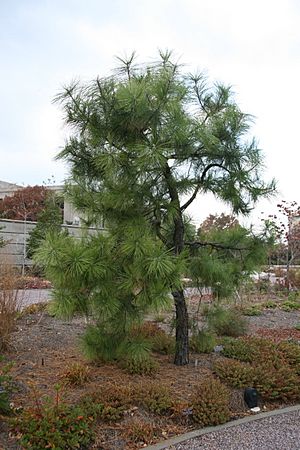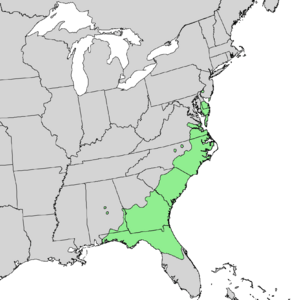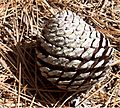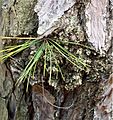Pond pine facts for kids
Quick facts for kids Pond pine |
|
|---|---|
 |
|
| Conservation status | |
| Scientific classification | |
 |
|
| Natural range |
The Pond Pine (Pinus serotina), also called the marsh pine or pocosin pine, is a type of pine tree. You can find it in the southeastern United States, along the Atlantic coast. Its home stretches from southern New Jersey all the way down to Florida and west to southern Alabama. This pine tree often has a bent or uneven shape and can grow up to 21 meters (about 69 feet) tall. Sometimes, it can even reach 29 meters (about 95 feet)!
Contents
What Makes Pond Pines Special?
Pond pine needles grow in groups of three or four. Each needle is about 15 to 20 centimeters (6 to 8 inches) long. The cones are almost round and are about 5 to 8 centimeters (2 to 3 inches) long. They have small, sharp points on their scales.
Its Special Cones
Pond pine cones are usually serotinous. This means they stay closed for a long time, sometimes for several years! To open and release their seeds, they need heat, often from a forest fire. The name serotina comes from this special feature, as it means "late" or "delayed" in Latin.
Where Pond Pines Live
Pond pines love wet places. You can often find them near ponds, in swampy areas, or in special wetlands called pocosins. They are often found growing near longleaf pines. This is because longleaf pines catch fire easily, and the pond pines need fire for their seeds to sprout.
How Pond Pines Are Different
At the northern part of its range, the pond pine sometimes mixes and creates new types of trees with the pitch pine (P. rigida). You can tell the pond pine apart from the pitch pine because its needles are longer. Also, its cones are usually a bit bigger. Some scientists even think that the pond pine is just a type of pitch pine.
-
Pond pine cones are smaller and rounder than loblolly pine cones.
See also
 In Spanish: Pinus serotina para niños
In Spanish: Pinus serotina para niños




